How to Tune a Piano?
Home » Piano Info » How to Tune a Piano?
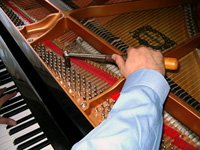
Pianos are tuned to make sure they sound right, and to keep them in good shape for a long time.
While piano tuning is complicated and done by professionals who have many years of experience, I am going to explain here how they work, introduce you to their tools, and show you how to tune a piano by tuning individual piano strings until the professional can come and tune the whole piano.
Sometimes one key might go out of tune in the middle of a rehearsal, a lesson or before a concert. It's impossible then to wait until your piano technician will come to fix the piano. Therefore it's handy to hold a tuning kit for an emergency case and only when you're sure you can fix the piano by yourself.
But, if you can wait a while, it's better to do nothing!
Just wait for your piano technician and let him do what he's good at!
By the way, spending sometime with your piano tecnician is the best way
to learn how to tune a piano.
What is piano tuning?
Piano tuning is the adjustment of the tuning pins in order to have the correct sounding and musical intervals in the piano.
Pianos usually consist of 88 keys, some of which have 2 or even 3 strings, so the professional tuner may have to tune more than 250 strings! In comparison, guitars consist of only 6 strings, which make them a lot easier and faster to tune.
How are pianos tuned?
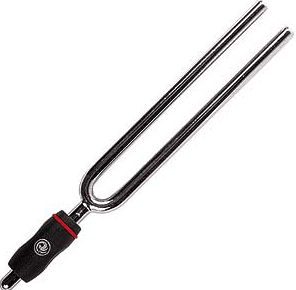
In order to learn how to tune your piano, the following tools are needed -
a tuning fork (or an electric tuner), rubber wedges, and tuning hammer.
I bought my Piano tuning kit
and they were quite cheap and very useful.
First...the tools that will help us finding the right pitch.
1. If you want to learn how to tune a piano in the old and classic method you should use the tuning fork. When banging the fork - it vibrates and produces a very clear sound. The basic fork is the one that produces the sound of A (frequency - 440 HZ). After the technician tunes the relevant key to the sound of the fork (there are three strings for that key), he tunes all the other strings relatively to the A pitch.

2. On the other hand, we can use an electric tuner which produces different sounds
for each of the strings of the piano. I bought one of these
Electronig Tuners
and found it easy to use.
3. Now you may wonder? How to tune a piano if I don't have these tools? Another way to tune the piano is by computer. there is a software available for this - for example TuneLab 97 (you will need a microphone to use this program).
And now to work!
First, you should look for the string behind the key that went out of tune.
Each key of the piano consists of one, two or three strings.
(The lowest keys have only one thick string, the middle keys have two, and the highest have three strings).
When we tune the piano, we pick only one string at a time, so if we tune a key that has three strings, we have to hold down (mute) the other strings so they won't vibrate. How is it done?
There are two ways to do this:
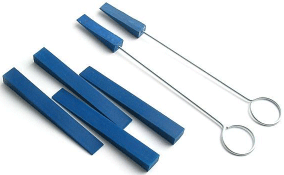
rubber tuning wedges or "mutes"-
Place the rubber mutes under the strings which are not being tuned in order to stop their vibration.
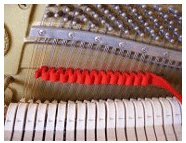 Using muting felt-
Using muting felt-
To tune multiple strings piano tuners may use a muting felt, instead of, or in addition to using rubber mutes. This is inserted between the strings and mutes the strings they do not wish to allow to vibrate.
Using the tuning hammer when learning how to tune a piano
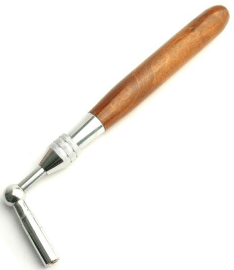
This tool is used to change the tension the strings of a piano
(why hammer - probably because of its shape, and not because you bang with it!).
It's a piece of metal with a handle, and its head has a socket like a wrench at the end.
Here is where you have to be careful -
while continuously striking the piano key firmly, slowly turn the pin
with the tuning wrench until the string is in tune.
It is very important to turn the pin very slowly as you may break the string
because there is already a lot of pressure on it!
If the string is broken all you have to do is open the other pin, and release the string.
Never, I repeat, never use a substitute hammer for
tuning the piano (any other tools - such as pliers).
You will damage the pin, and it will cost a lot of money to replace it.
Buy a real Piano Tuning Hammer
from here instead and make sure you know what you're doing.
.
Piano tuners are specialists - At the beginning they use their tuning forks on middle C (or A) -
starting with a string in the middle of the piano and then they get on with the job - all by ear!
The middle octave is tuned exactly,
but the higher notes are a bit sharpened and the lower notes are slightly flattened.
This is one of the reasons you should not tune your whole piano by your self using an electric tuner for each of the strings-tuning piano is an art and the professional knows the nuances when tuning the whole piano.
After - what we think is a nerve wracking couple of hours of cacophony - here we have a tuned piano with a perfect sound and pitch.
An advice - how to choose a piano technician
Some websites try to answer the question how to tune a piano as well, and they claim you can tune a piano by yourself. I think it could be very dangerous for the piano or for yourself if you break a piano that is used by your wife/husband/children or your mother-in-law! A tuning hammer bashed into your head could be quite painful as well!
And now, seriously - I'd be happy to help you to find the right technician that will also teach you how to tune a piano yourself.
Choosing a technician:
Choose your piano technician carefully. There is no license required
for tuning pianos, and that is the reason that there are untrained people who might
cause damage to your piano.
The best thing to do is to find a registered tuner-technician:
a member of the "Piano Technicians Guild" or a similar organization -
which means he or she were examined by experts.
If you don't have a guild in your area don't worry, there are many ways to get a professional.
Call your local conservatory, music school or even orchestra, and ask them to recommend a technician.
Of course, recommendations from friends would also be very helpful.
How often should the piano be tuned?
There are various schools of thought - concert pianos are tuned before each concert.
It is recommended to tune the piano between two to four times a year,
but not less than once a year!
Weather conditions can affect the piano, and if there are extreme climatic changes,
the piano might go out of tune more often.
However, not all piano players are professional and if the piano is in
a good shape and not placed near the kitchen oven,
in front of the sun, or in the backyard, once a year could be enough.
It is necessary to let a professional check your piano at least once a year
in order to see if there are problems which should be fixed.
When your tecnician arrives ask him how to tune a piano yourself.
He'll probably give you a tip or two.
I have played on many kinds of pianos, and although I know how to tune the piano
(after spending many hours, working with technicians),
I prefer to let the professional get on with the job. I recommend that you do so too.
Admittedly, this costs money, but it guarantees the healthy sound of your piano and its long life.
I hope you have more idea on how to tune a piano after reading this article.
If you'd like to go into the small details I suggest you call your piano tecnician
and ask him to show you how to tune a piano step by step.
There's nothing better then a descent demonstration!
Return from How to Tune a Piano to Piano Information
Return from How to Read Sheet Music to Free Piano Sheet Music














